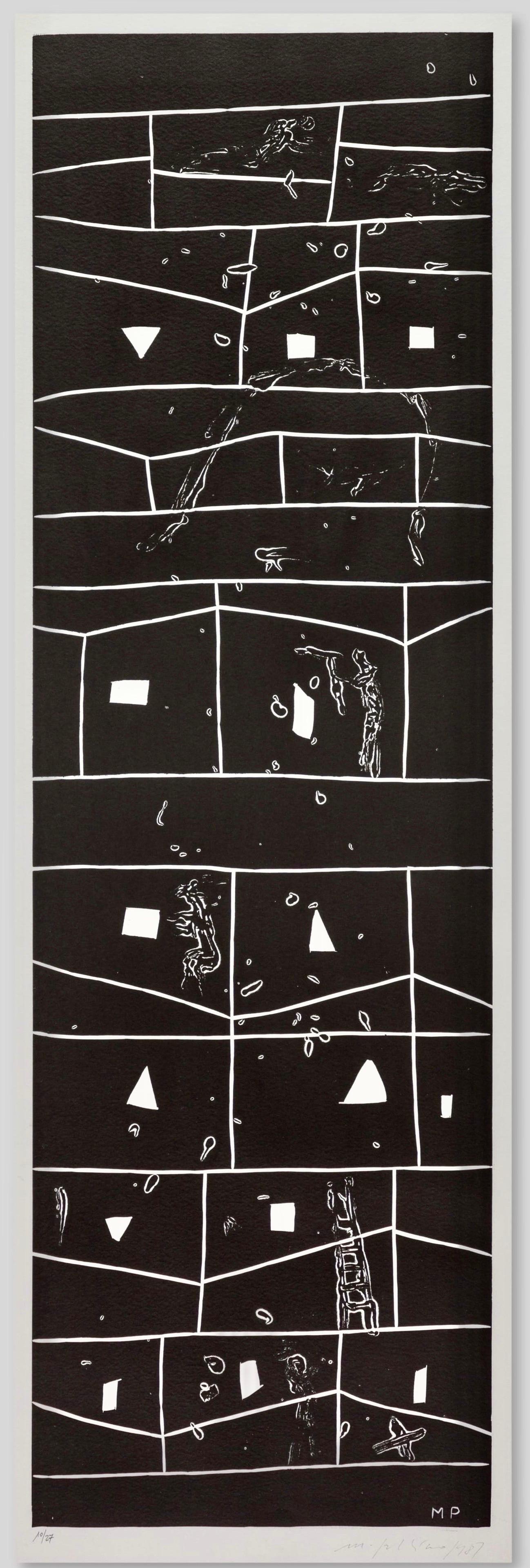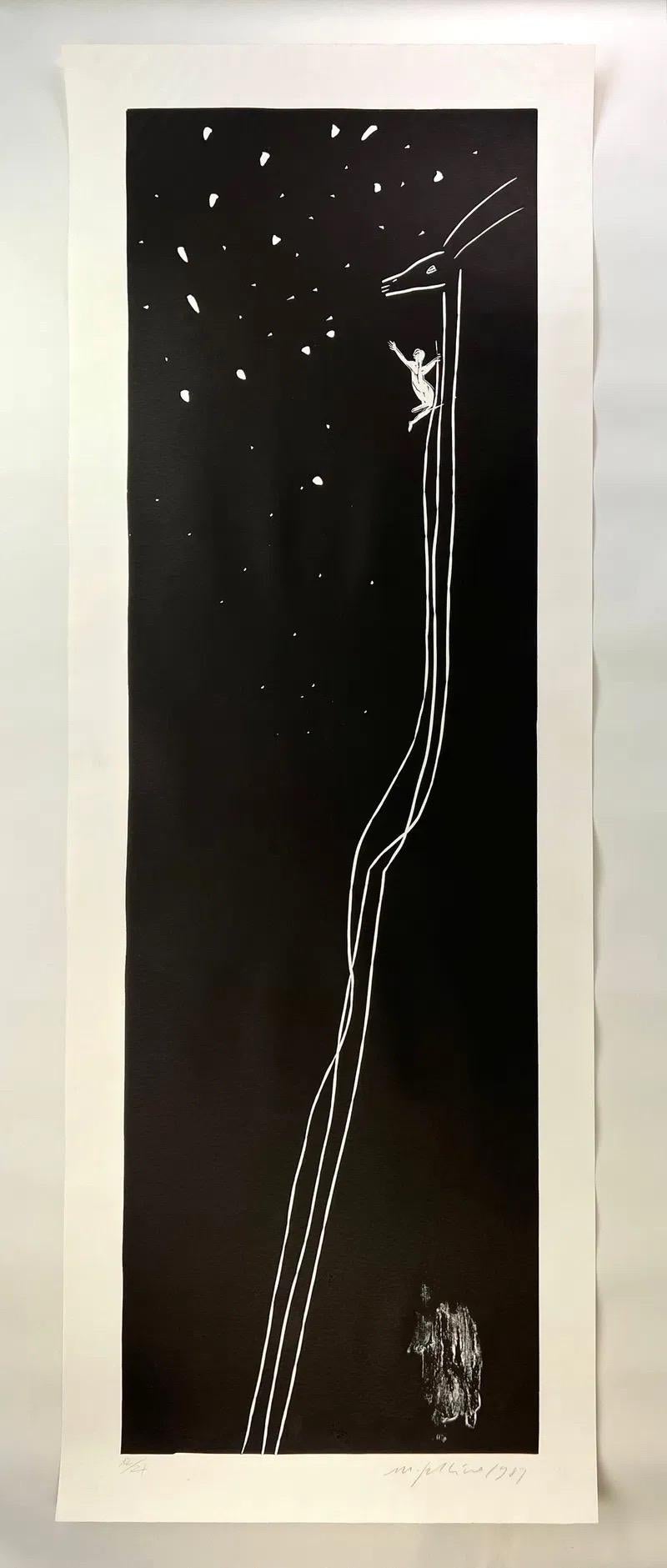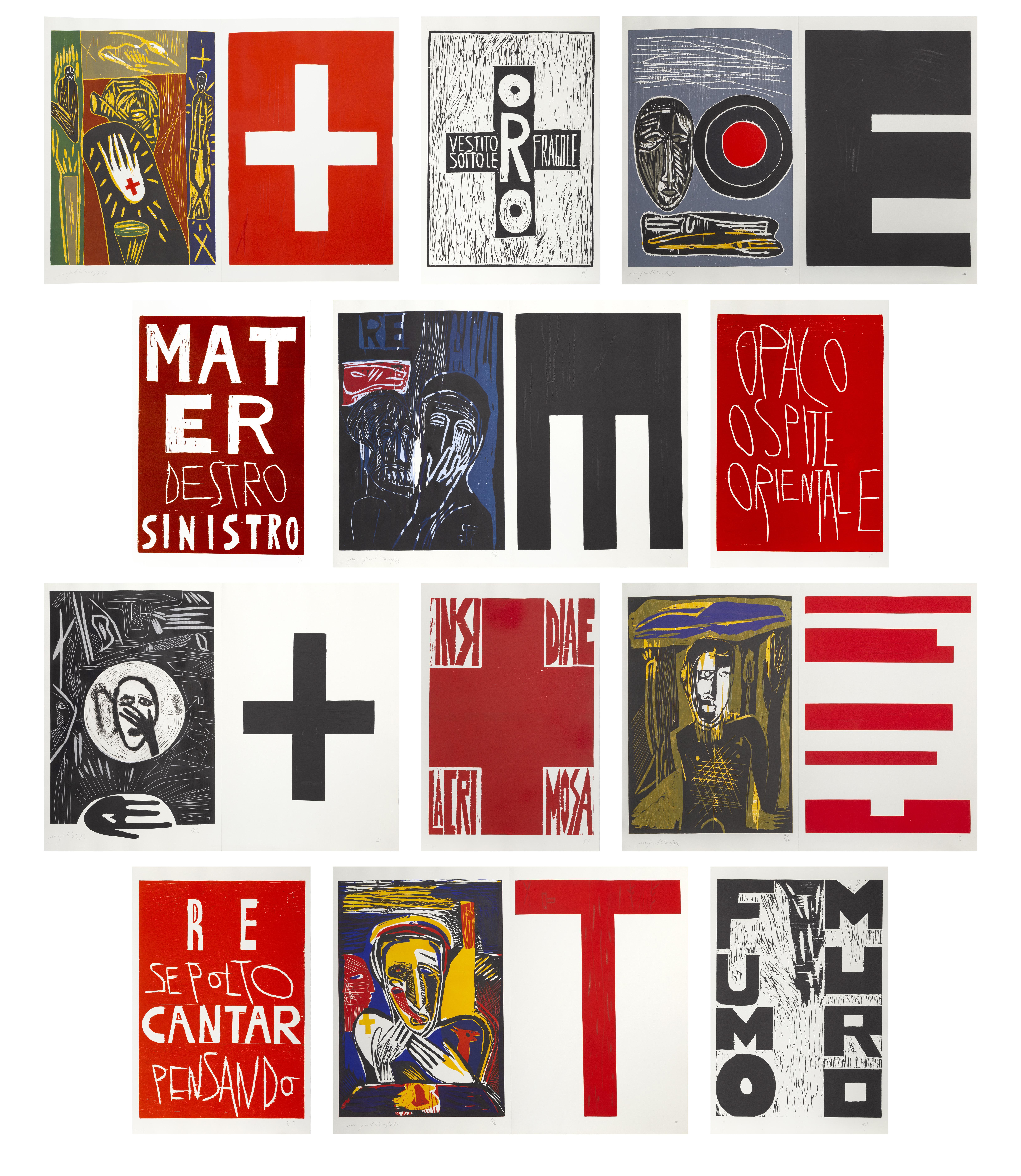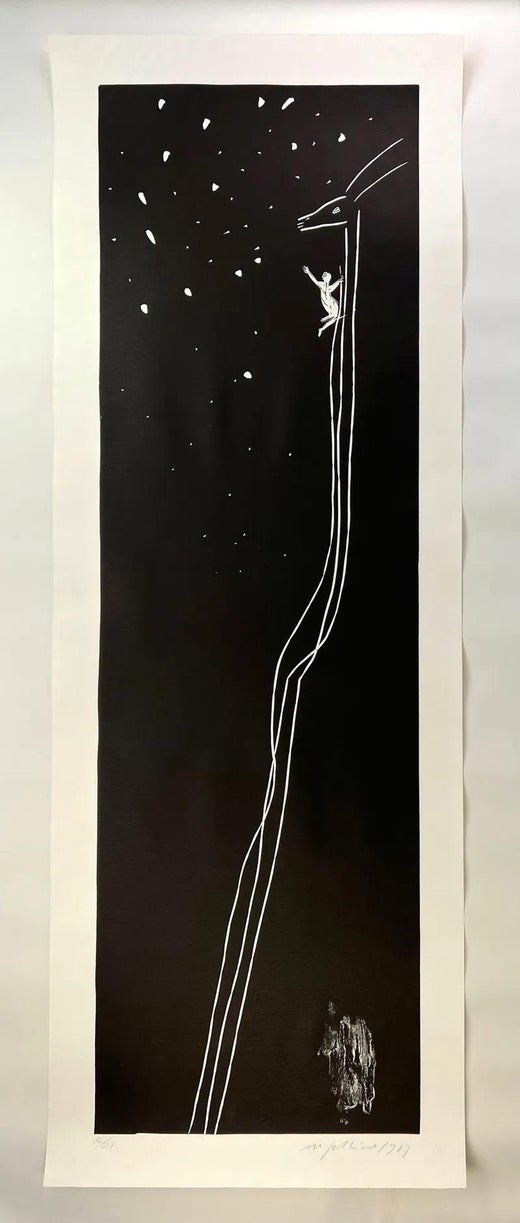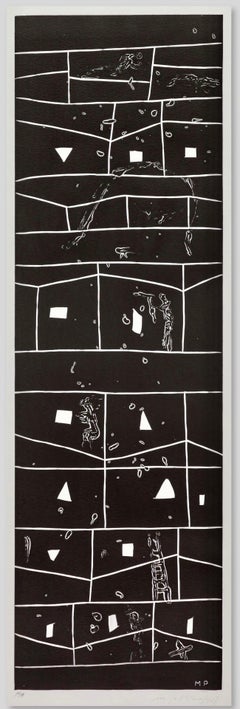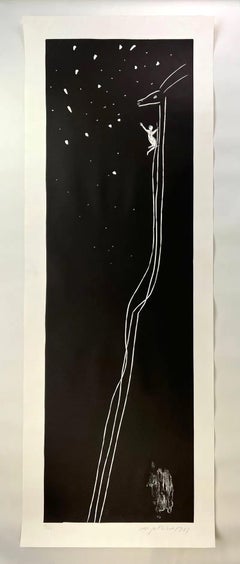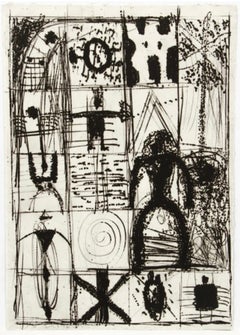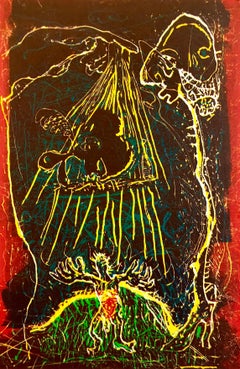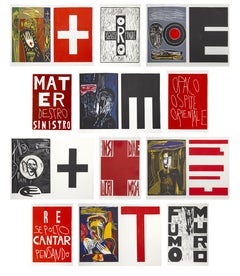Items Similar to Huge Italian Neo Expressionist Mimmo Paladino Linoleum Block Print Atlantico
Want more images or videos?
Request additional images or videos from the seller
1 of 14
Mimmo PaladinoHuge Italian Neo Expressionist Mimmo Paladino Linoleum Block Print Atlantico1987
1987
$5,500
£4,295.94
€4,869.96
CA$7,884.87
A$8,649.27
CHF 4,525.43
MX$102,943.50
NOK 57,158.95
SEK 53,616.12
DKK 36,371.56
About the Item
Mimmo Paladino
Atlantico
Linocut, 1987, hand signed, dated and numbered 12/27 in pencil.
Medium: Collagraph and linoleum cut
Sheet measures 82 x 29 1/2" inches
Parole Torchon paper
Published by Waddington Graphics, London
Giorgio Upiglio - Grafica Uno printer, Milan.
Publications: Mimmo Paladino's graphics by Enzo Di Martino, Ed. Art of this Century, n.104, p.125
Atlantico is a 1987 linocut print by Mimmo Paladino from the rare series of seven graphically charged prints, entitled Atlanico. This is from an edition of 27 plus artist and printers proofs. The large scale monochromatic, black and white print is hand signed by Paladino.
Mimmo Paladino (born in Paduli, Campania, Italy in 1948) is an Italian sculptor, painter and printmaker. He is a leading name in the Transavanguardia artistic movement and one of the many European artists to revive Expressionism in the 1980s.
From 1964 until 1968, he attended Liceo Artistico di Benevento where he was influenced by American pop art artists Claes Oldenburg and Jim Dine. He made his debut in 1968 with a solo exhibition at the Galleria Carolina in Portici in Naples. Here he was presented by Achille Bonito Oliva, who was also present for the monograph show at Enzo Cannaviello Studio Oggetto in Caserta the following year. However, we need to go back to 1964 to find the first major date in his artistic education. This was when, still a schoolboy, he visited the 32nd Venice Biennale and, in particular, the U.S. Pavilion, where he discovered the American Pop art artists. In the early 1970s, his approach shifted towards conceptual art and photography, but by the mid-decade his painting had acquired considerable importance.
In the late seventies, Paladino moved to Milan, where he later taught artistic disciplines at the Liceo school, while also working on his art. In 1977 came his first collaboration with Lucio Amelio, the historic gallery owner in Naples, and two years later he put on his first exhibition with another key gallerist, Emilio Mazzoli of Modena, for whom he made his first book-object – En-De-Re – in 1980. This was indeed another crucial year, for it was when he put on his first solo exhibition in New York (where he had just taken up temporary residence), in two different galleries – those of Marian Goodman and Annina Nosei. International interest in his work and in that of other young Italians was growing, and in 1980 a traveling exhibition took works by Sandro Chia, Francesco Clemente, Sandro Cucchi, Nicola De Maria and Paladino, together with two other artists, Luigi Ontani and Ernesto Tatafiore, to three of the most important museums in Europe. It was also the year of the 39th Venice Biennale, where Harald Szeemann and Achille Bonito Oliva curated the Aperto section, choosing some of the artists who were to make their mark on the art scene for many years to come. It was here that Transavanguardia became more firmly established, with its theoretical structure being published the following year. Regarded as the Italian version of Neo-Expressionism, Transavantgarde revived the emotion, figuration and mysticism in art. Paladino’s figurative sculptures, paintings and prints often reference past art historical traditions, modernizing iconography with distinct, graceful elongation.
The eighties were dominated largely by Neo-Expressionist paintings. There were Germans, such as Georg Baselitz, Anselm Kiefer, Gerhard Richter, A. R. Penck, and the Italians, Francesco Clemente, Sandro Chia, Enzo Cucchi, Mimmo Paladino as well as Julian Schnabel, Eric Fischl, Jean Michel Basquiat, David Salle, and many others, their paintings were figuratively based. There was a group of painters who were working more in the vein of what Stephen Westfall referred to as “Neo-Surrealism,” including George Condo, Jeffrey Wasserman, Kenny Scharf and David Humphrey. Clemente was in a photo with pop art master Andy Warhol, Jean-Michel Basquiat and Bruno Bischofberger in 1984. The arrival of the young Italian painters was seen by many as a breath of fresh air and a key exhibition like Zeitgeist, in Berlin, certainly indicated their progress, with German-speaking countries as the first to promote their work. he has forayed into sculpture (his first work, Closed Garden, is now at Castello di Rivoli) and engraving. However, his basic conception is always pictorial, even when three-dimensional, as in the case of It Will Have No Title, with the use of geometrical elements applied to the environment, the first result of which came in 1995. In 1994 he was the first Italian to exhibit in the Forbidden City in Beijing, China. In 2006 Paladino made his short feature film Quijote, devoted to the work by Cervantes. Presented at the Venice Film Festival, the movie captures the essence of the art of the masterpiece in a highly imaginative series of evocations, sounds and inventions. Great literature is an underlying thread that, over the years, has led him to illustrate the icons of world culture, such as Tristes Tropiques, Ulysses, the Homeric poems, Pinocchio and, of course, Don Quixote. Paladino was back behind the camera in 2013 to film Labyrinthus for the fourth centenary of the death of the madrigal composer Gesualdo da Venosa. Here too, his collaboration with the world of music goes back a long way, with numerous mises en scène for opera houses, the creation of opera posters for Maestro Riccardo Muti and requests for music for his installations, as was the case in 1999 with Brian Eno for Sleepers, in London and then, in 2008, for the Ara Pacis in Rome.
In 2013 he was commissioned to make a monumental installation for the Piazza Santa Croce in Florence, where he used blocks of marble and bronze sculptures for a large temporary project.
Paladino was made an honorary member of the Royal Academy of Arts, London on 26 May 1999.
His work is in many public museum collections including the Metropolitan Museum of Art, Tate, Museum of Modern Art, among others. Het has exhibited internationally, including at the 1980 Venice Biennale and the 1982 documenta VII. His work can be found in prominent collections worldwide, notably the Hirshhorn Museum and Sculpture Garden (Washington, D.C), Metropolitan Museum of Art (New York), Museum of Fine Arts (Houston) and Tate Modern (London).
- Creator:Mimmo Paladino (1948, Italian)
- Creation Year:1987
- Dimensions:Height: 82 in (208.28 cm)Width: 29.5 in (74.93 cm)
- Medium:
- Movement & Style:
- Period:
- Condition:this will ship rolled in a wide sturdy tube.
- Gallery Location:Surfside, FL
- Reference Number:1stDibs: LU38215831342
Mimmo Paladino
Mimmo Paladino (b. 1948, Italy) played a central role in the development of the Transavantgarde movement alongside Sandro Chia and Francesco Clemente. Regarded as the Italian version of Neo-Expressionism, Transavantgarde revived the emotion, figuration and mysticism in art. Paladino’s sculptures, paintings and prints often reference past art historical traditions, modernizing iconography with distinct, graceful elongation. Paladino attended the Benevento Art High School, where he was influenced by Pop artists Claes Oldenburg and Jim Dine. The artist has exhibited internationally, including at the 1980 Venice Biennale and the 1982 documenta VII. His work can be found in prominent collections worldwide, notably the Hirshhorn Museum and Sculpture Garden (Washington, D.C), Metropolitan Museum of Art (New York), Museum of Fine Arts (Houston) and Tate Modern (London).
About the Seller
4.9
Platinum Seller
Premium sellers with a 4.7+ rating and 24-hour response times
Established in 1995
1stDibs seller since 2014
1,836 sales on 1stDibs
Typical response time: 1 hour
- ShippingRetrieving quote...Shipping from: Surfside, FL
- Return Policy
More From This Seller
View AllHuge Italian Neo Expressionist Mimmo Paladino Linoleum Block Print Atlantico
By Mimmo Paladino
Located in Surfside, FL
Mimmo Paladino
Atlantico
Linocut, 1987, hand signed, dated and numbered 12/27 in pencil.
Medium: Collagraph and linoleum cut
Sheet measures 82 x 29 1/2" inches
Parole Torchon pap...
Category
1980s Neo-Expressionist Abstract Prints
Materials
Linocut
Huge Italian Neo Expressionist Mimmo Paladino Linoleum Block Print Atlantico
By Mimmo Paladino
Located in Surfside, FL
Mimmo Paladino
Atlantico
Linocut, 1987, hand signed, dated and numbered 12/27 in pencil.
Medium: Collagraph and linoleum cut
Sheet measures 82 x 29 1/2" inches
Parole Torchon pap...
Category
1980s Neo-Expressionist Abstract Prints
Materials
Linocut
Spanish Artist Santi Moix Aquatint Etching Ed 2/3 Surrealist Abstract Symbols
By Santi Moix
Located in Surfside, FL
Moix, Santi (Spanish, b. 1960), Figural Abstraction, hybrid print with etching and aquatint, 23.5 x 16.75 inches, pencil signed and numbered 2/3.
Santi Moix (Barcelona, 1960) lives ...
Category
20th Century Surrealist Abstract Prints
Materials
Etching, Aquatint
Large Abstract Expressionist Figure Handmade Paper Etching Silkscreen Print
By Sam Messer
Located in Surfside, FL
This is done on a very interesting handmade paper (Japanese?) it is hand signed and numbered.
In this print the artist Sam Messer uses bold contrasting colors in a gestural manner. Messer's work, so apparently spontaneous or impulsive in its emphasis on highly dramatic gestural brushstrokes and intense color, is, in fact, carefully considered. The treatment of the composition conveys dynamic movement through the sweep...
Category
1980s Abstract Expressionist Abstract Paintings
Materials
Handmade Paper, Lithograph, Screen
Marino Marini Italian Modernist Il Teatro Etching Hand Signed and Numbered
By Marino Marini
Located in Surfside, FL
From deluxe Roman numeral edition of 20. hand signed Il Teatro from Imagines. Horse and rider.
He attended the Accademia di Belle Arti in Florence in 1917. Although he never abando...
Category
20th Century Modern Figurative Prints
Materials
Etching
Marino Marini Etching "Miracle" Hand Signed and Numbered
By Marino Marini
Located in Surfside, FL
image 11.5X16.75
He attended the Accademia di Belle Arti in Florence in 1917. Although he never abandoned painting, Marini devoted himself primarily to sculpture from about 1922. Fr...
Category
20th Century Modern Figurative Prints
Materials
Etching
You May Also Like
Muto
By Mimmo Paladino
Located in Long Island City, NY
Artist: Mimmo Paladino, Italian (1948 - )
Title: Muto
Year: 1984
Medium: Etching and aquatint in colors with mink fur collage, signed and numbered in pencil
Edition: 17/35
Size: 60.5...
Category
1980s Contemporary Figurative Prints
Materials
Etching
Price Upon Request
Lacrimose Portfolio, Collection of 12 Pop Art Woodcuts by Mimmo Paladino
By Mimmo Paladino
Located in Long Island City, NY
Artist: Mimmo Paladino, Italian (1948 - )
Title: Lacrimose Portfolio
Year: 1986
Medium: Portfolio of Twelve Woodcuts, Each signed and numbered in pencil
Edition: 18/42
Size: 31 x 21 ...
Category
1980s Contemporary Figurative Prints
Materials
Woodcut
Marino Marini (1901-1980) - Miracolo - Lithograph on BFK Rives paper
By Marino Marini
Located in Varese, IT
Lithograph on BFK Rives paper hand signed by the artist
Current numbered example: 43/125
Paper size: 89.5 x 63.5
Bibliography:
Marino Marini Catalog Raisonné of Graphic Works ref L8...
Category
1960s Abstract Prints and Multiples
Materials
Lithograph
"l'Attesa" Large original colors lithograph
By Marino Marini
Located in San Francisco, CA
This artwork titled "l'Attesa" 1965, is an original color lithograph on BFK Rives paper by noted Italian artist Marino Marini, 1901-1980. It is hand signed and numbered 38/60 in penc...
Category
Mid-20th Century Post-Modern Animal Prints
Materials
Lithograph
"Triade" by Marino Marini, Lithography, Triad, Figurative Print
By Marino Marini
Located in Köln, DE
Set of 3 etchings and aquatints in colours by Marino Marini
"Triade", 1976-1978
73,7 x 57,5 cm
Copy 4/90
Edition of 125
Marino Marini (Pistoia 1901–1980 Viareggio 1980) - Hardly an...
Category
1970s Modern Figurative Prints
Materials
Etching, Aquatint
Marino Marini - Original Lithograph
By Marino Marini
Located in Collonge Bellerive, Geneve, CH
Marino Marini - Knight - Original Lithograph
1970
Dimensions: 32 x 24 cm
From the art review XXe siècle
Unsigned and unumbered as issued
Category
1970s Surrealist Animal Prints
Materials
Lithograph
More Ways To Browse
Neo Vintage
Vintage Italy Print
Forbidden City
Lucio Amelio
Space Invader Print
The Paris Review Print
Tim Walker
Victor Vasarely Vega
Victor Vasarely Zebra
Vintage Band Flyers
Vintage Travel Posters Book
Voyage Around The World Litho
Welcome Mat
Ace Gallery Poster
Alan Cote
Alan Thompson
Alexander Calder Balloons
Alexander Calder Hand Signed
